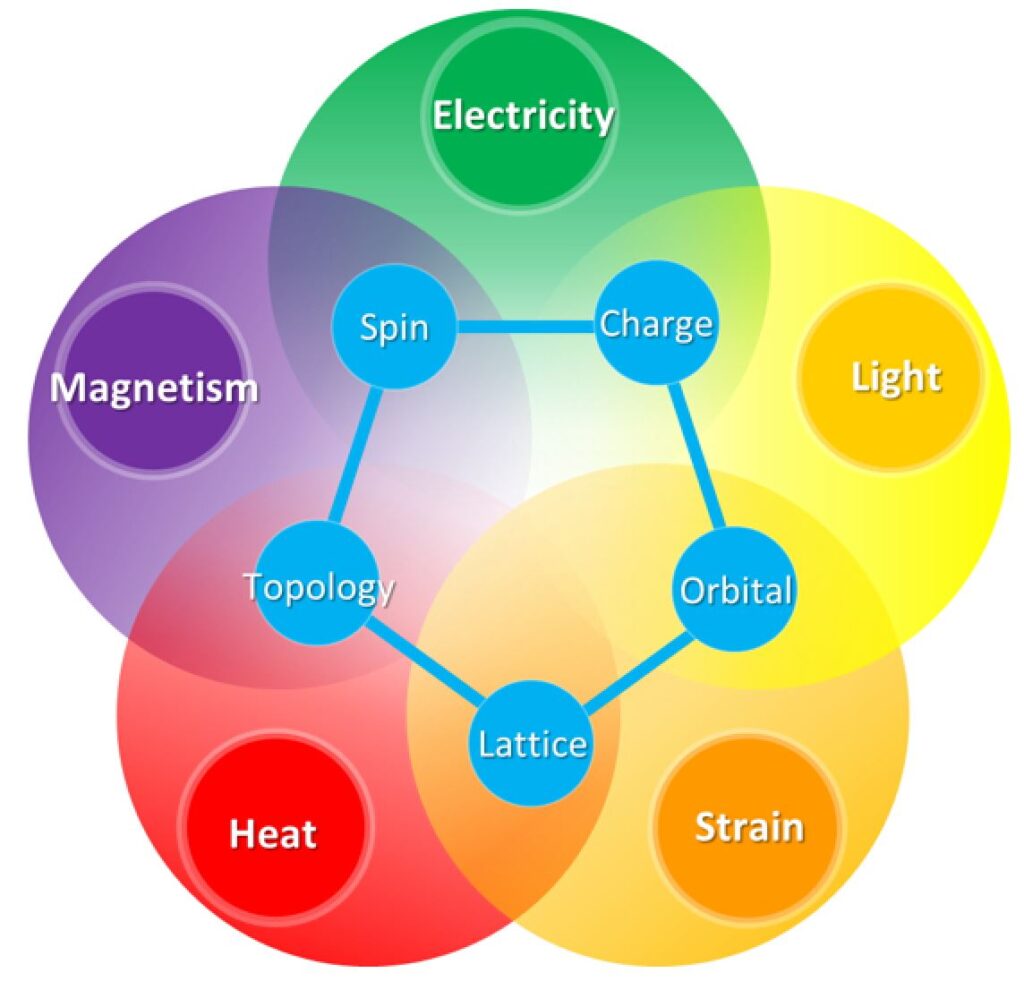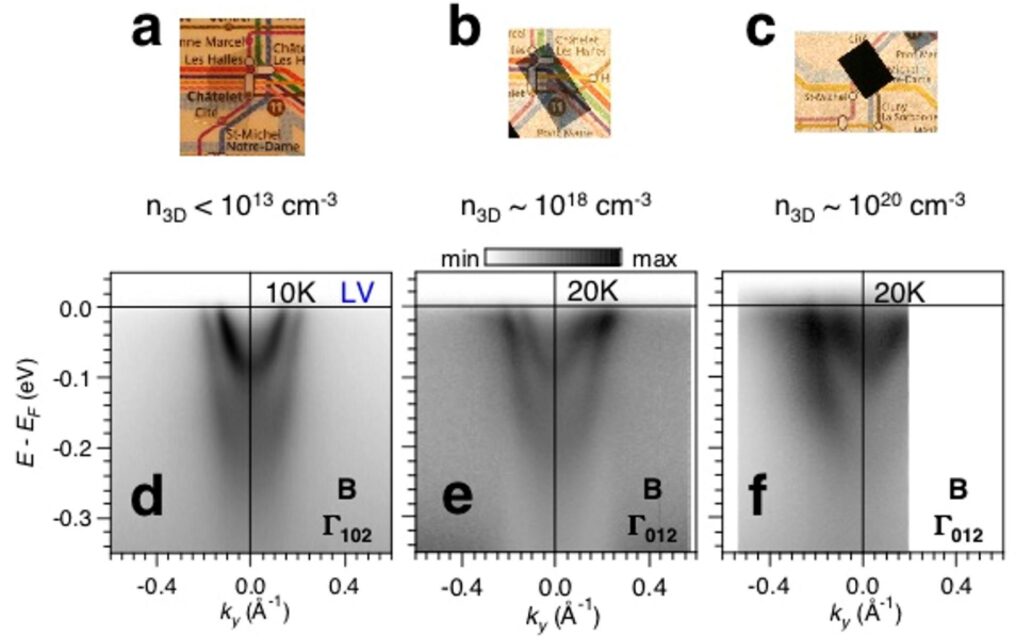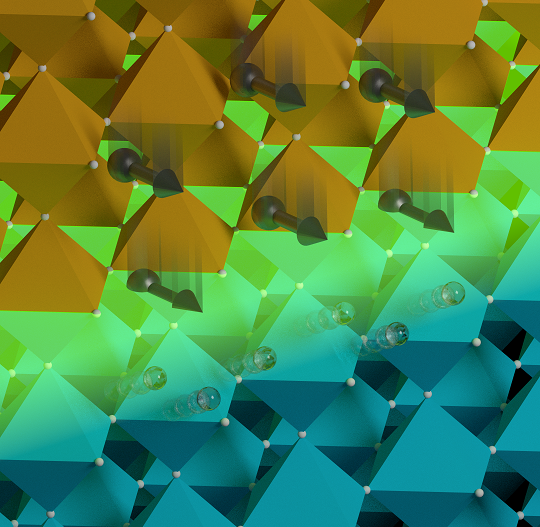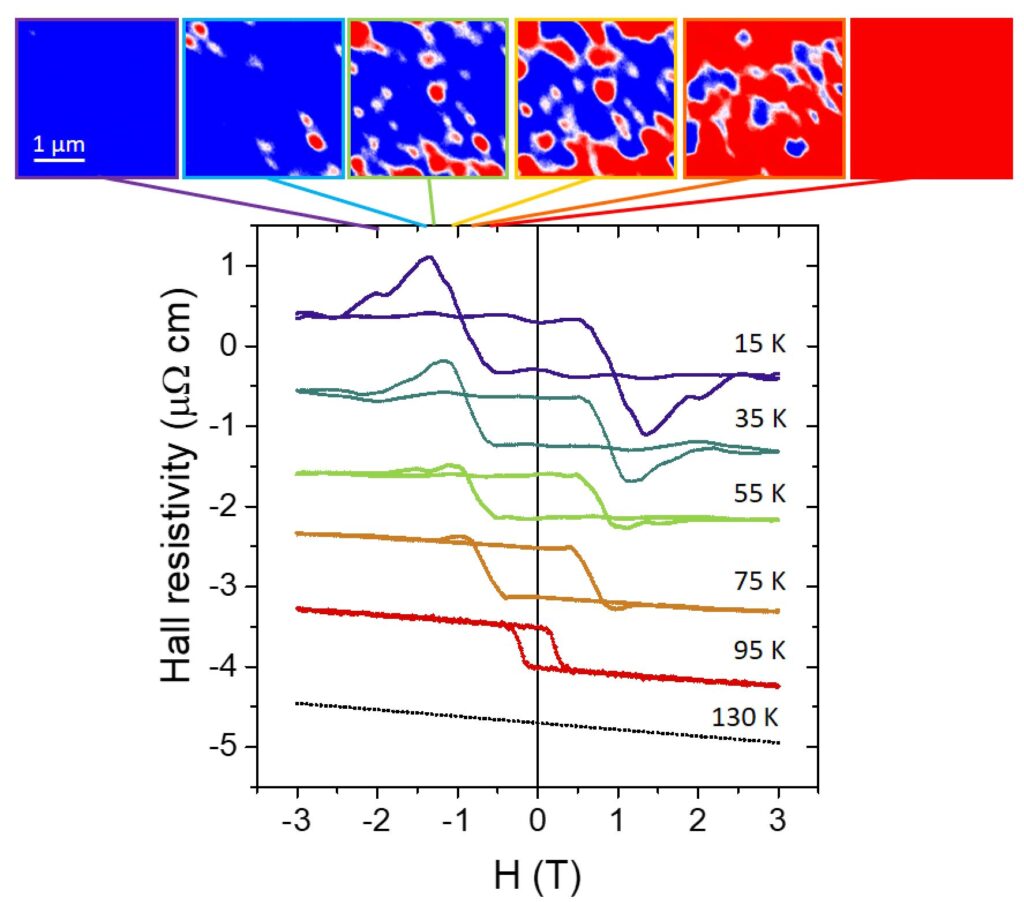The rich physics of transition metal oxides is related to the delicate balance between charge, spin and orbital degrees of freedom. The ensuing large diversity of functional properties (insulators, metals, superconductors, ferromagnets, antiferromagnets, ferroelectrics, etc) is observed in materials that cristallise in a few structural families, such as the perovskite structure. This allows for the growth of heterostructures with very high structural quality, and with modern synthesis methods, it is possible to engineer interfaces between complex transition metal oxides with an atomic-scale precision (such as the epitaxial manganite-based tunnel junctions that we started to study several years ago). For more information you may consult our review in Adv. Phys.

Oxide 2-dimensional electron gases
Direct mapping of charge carrier of the 2DEG at the LaAlO3/SrTiO3 interface
LaAlO3 (LAO) and SrTiO3 (STO) are two wide bandgap insulators that share the same pseudo-cubic perovskite structure. Quite unexpectedly, in 2004 Ohtomo and Hwang reported that samples consisting of an LAO thin film epitaxially grown onto a single-crystalline (001)-oriented STO substrate showed a metallic behavior, with an electronic mobility reaching about 10000 cm²/Vs at low temperature.
We have found that this high-mobility behaviour is very sensitive to the growth conditions, and that in samples non-reoxygenated after growth, the whole STO subtrates becomes a high-mobile conductor due to n-type doping by oxygen vacancies. Only in reoxygenated samples can conductivity be confined to a few nm close to the interface, as evidence by conductive-tip AFM imaging in cross-section LAO/STO samples. This strongly suggests that in these conditions the electron gas is truly two-dimensional, and thus emerges as a new model system for studying quantum transport phenonema in oxide nanostrucutures.

Part of this research was carried out in collaboration with the University of Zagreb (A. Hamzic, M. Basletic, E. Tafra) and ICMAB Barcelona (G. Herranz).
Some related publications
G. Herranz, M. Basletic, M. Bibes, C. Carrétéro, E. Tafra, E. Jacquet, K. Bouzehouane, C. Deranlot, A. Hamzic, J.-M. Broto, A. Barthélémy, and A. Fert
High Mobility in LaAlO3/SrTiO3 Heterostructures: Origin, Dimensionality, and Perspectives
Phys. Rev. Lett. 98, 216803 (2007)
M. Basletic, J.-L. Maurice, C. Carrétéro, G. Herranz, O. Copie, M. Bibes, E. Jacquet, K. Bouzehouane, S. Fusil and A. Barthélémy
Mapping the spatial distribution of charge carriers in LaAlO3/SrTiO3 heterostructures
Nature Mater. 7, 621 (2008)
O. Copie, V. Garcia, C. Bödefeld, C. Carrétéro, M. Bibes, G. Herranz, E. Jacquet, J.-L. Maurice, B. Vinter, S. Fusil, K. Bouzehouane, H. Jaffrès, and A. Barthélémy
Towards Two-Dimensional Metallic Behavior at LaAlO3/SrTiO3 Interfaces
Phys. Rev. Lett. 102, 216804 (2009)
A 2DEG at the surface of SrTiO3
A 2DEG can not only form at the interface between STO and LAO, but also at the surface of STO. In collaboration with CSNSM and Synchrotron SOLEIL, we have used angle-resolved photoemission spectroscopy to show that there is a highly metallic universal 2DEG at the vacuum-cleaved surface of SrTiO3 (including the non-doped insulating material) independently of bulk carrier densities over more than seven decades. This 2DEG is confined within a region of about five unit cells and has a sheet carrier density of 0.33 electrons per square lattice parameter. The electronic structure consists of multiple subbands of heavy and light electrons. Our discovery provides a model system for the study of the electronic structure of 2DEGs in SrTiO3-based devices and a novel means of generating 2DEGs at the surfaces of transition-metal oxides.

Collaboration with CSNSM (A. Santander), Synchrotron SOLEIL (P. Le Fèvre, F. Bertran), C2N (Ph. Lecoeur) and LPS (M. Gabay and M. Rozenberg).
Selected publications :
A. F. Santander-Syro, O. Copie, T. Kondo, F. Fortuna, S. Pailhès,R. Weht, X. G. Qiu, F. Bertran, A. Nicolaou, A. Taleb-Ibrahimi, P. Le Fèvre, G. Herranz, M. Bibes, N. Reyren, Y. Apertet, P. Lecoeur, A. Barthélémy and M. J. Rozenberg
Two-dimensional electron gas with universal subbands at the surface of SrTiO3
Nature 469, 189 (2011)
A. F. Santander-Syro, C. Bareille, F. Fortuna, O. Copie, M. Gabay, F. Bertran, A. Taleb-Ibrahimi, P. Le Fèvre, G. Herranz, N. Reyren, M. Bibes, A. Barthélémy, P. Lecoeur, J. Guevara and M. J. Rozenberg
Orbital symmetry reconstruction and strong mass renormalization in the two-dimensional electron gas at the surface of KTaO3
Phys. Rev. B 86, 121107 (2012)
Tuning the critical LaAlO3 thickness for 2DEG formation by metal capping
One of the hallmark features of the LAO/STO 2DEG is the existence of a critical LaAlO3 thickness of 4 unit-cells (uc) for interfacial conductivity to emerge. However, working with LAO/STO samples capped with different metals we have found that this thickness can be strongly varied. The results show that for metals with low work function a 2DEG forms at 1–2 uc of LaAlO3 and is accompanied by a partial oxidation of the metal, a phenomenon that affects the 2DEG properties and triggers the formation of defects. In contrast, for noble metals, the critical thickness is increased above 4 uc. We discussed the results in terms of a hybrid mechanism that incorporates electrostatic and chemical effects.

Selected publications :
D.C. Vaz, E. Lesne, A. Sander, H. Naganuma, E. Jacquet, J. Santamaria, A. Barthélémy and M. Bibes
Tuning up or down the critical thickness in LaAlO3/SrTiO3 through in situ deposition of metal overlayers
Adv. Mater. 29, 1700486 (2017)
Diogo Castro Vaz, Edouard Lesne, Anke Sander, Hiroshi Naganuma, Eric Jacquet, Jacobo Santamaria, Agnès Barthélémy, Manuel Bibes
Growth and Electrostatic/chemical Properties of Metal/LaAlO3/SrTiO3 Heterostructures
J. Vis. Exp. e56951 (2018) doi:10.3791/56951
Spin injection into the LaAlO3/SrTiO3 2DEG
Recently, we have been able to inject spins into the LAO/STO interface, which paves the way towards a new era in oxide spintronics, beyond perpenidcular devices such as tunnel junctions or spin filters. The main challenge is now to transport spins in the two-dimensional electron gas (2DEG), and detect them with ferromagnetic contacts. The advantage of using oxide channels compared to graphene or classical semi-conductors lies in the compatibility of this 2DEG with various functional oxides (providing novel possibilities for charge and spin transport mainpulation in the channel), and the large Rashba spin-orbit coupling that can also be used to control spin transport by a voltage.

Some related publications :
N. Reyren, M. Bibes, E. Lesne, J.-M. George, C. Deranlot, S. Collin, A. Barthélémy and H. Jaffrès
Gate-Controlled Spin Injection at LaAlO3/SrTiO3 Interfaces
Phys. Rev. Lett. 108, 186802 (2012)
M. Bibes, N. Reyren, E. Lesne, J.-M. George, C. Deranlot, S. Collin, A. Barthélémy and H. Jaffrès
Towards electrical spin injection into LaAlO3–SrTiO3
Phil. Trans. R. Soc. A 370, 4958 (2012)
Spin-charge conversion by the inverse Edelstein effect in LaAlO3/SrTiO3
In recent years, the interest of fundamental spintronics research has focused on the use of a relativistic effect, spin-orbit coupling, to generate spin currents in non-magnetic materials. As its name suggests, this effect couples the spin and the orbital moment of the electron, and allows to manipulate the electron’s spin. Its use revolutionizes the way spintronics devices such as memories, microwave generators or spin-based logic operations work. The LAO/STO 2DEG hosts a Rashba-type spin-orbit coupling, which can be harnessed for spin-charge interconversion. Using spin-pumping to inject a spin current from a ferromagnet (NiFe) into the 2DEG, we measured the converted charge current. The conversion obtained is remarkable, not only for its efficiency, but also because it can be modulated in amplitude and sign by a gate voltage. This demonstration opens the way to various studies on the use of this high conversion rate on the manipulation of magnetization, the search for new sources of modulable spin current as well as to new types of spin transistors, in particular because it is in principle possible to also perform the reverse operation, i. e. to generate an angular moment (spin) from an electric current (charge).

This work was performed in collaboration with Spintec (L. Vila, J.P. Attané).
Related publications :
E. Lesne, Yu Fu, S. Oyarzun, J. C. Rojas-Sánchez, D. C. Vaz, H. Naganuma, G. Sicoli, J.-P. Attané, M. Jamet, E. Jacquet, J.-M. George, A. Barthélémy, H. Jaffrès, A. Fert, M. Bibes and L. Vila
Highly efficient and tunable spin-to-charge conversion through Rashba coupling at oxide interfaces
Nature Mater. 15, 1261 (2016)
J. Varignon, L. Vila, A. Barthélémy and M. Bibes
A new spin for oxide interfaces
Nature Phys. 14, 322 (2018)
Mapping the spin-charge conversion efficiency to the band structure in a topological oxide 2DEG
While spintronics has traditionally relied on ferromagnetic metals as spin generators and detectors, spin-orbitronics exploits the efficient spin-charge interconversion enabled by spin-orbit coupling in non-magnetic systems. This is providing new opportunities for devices, such as the MESO transistor proposed by Intel, that relies on writing of magnetic information through magnetoelectric coupling, and reading it by spin-charge conversion. For the latter, oxide 2DEGs are promising as their spin-charge conversion efficiency is large (see our earlier work with LaAlO3/SrTiO3 2DEGs). In a new paper just published in Nature Materials, we demonstrate a very large spin to-charge conversion effect in an high carrier-density SrTiO3 2DEG generated by the sputter-deposition of Al at room temperature, and map the dependence of this effect to the band structure (as measured by ARPES). We show that the conversion process is amplified by enhanced Rashba-like splitting due to orbital mixing, and in the vicinity of avoided band crossings with topologically non-trivial order. Our results indicate that oxide 2DEGs are strong candidates for spin-based information readout in novel memory and transistor designs, and emphasize the promise of topology as a new ingredient to expand the scope of complex oxides for spintronics.

This work was performed in collaboration with Spintec and CEA-Inacin Grenoble, the Martin-Luther-Universität Halle-Wittenberg, the LPEM at ESPCI Paris, the Laboratoire de Physique des Solides in Orsay, the University of Geneva and the Helmholtz-Zentrum Berlin.
Selected publication :
Mapping spin-charge conversion to the band structure in a topological oxide two-dimensional electron gas
Diogo C. Vaz, Paul Noël, Annika Johansson, Börge Göbel, Flavio Bruno, Gyanendra Singh, Siobhan McKeown-Walker, Felix Trier, Luis M. Vicente-Arche, Anke Sander, Sergio Valencia, Pierre Bruneel, Manali Vivek, Marc Gabay, Nicolas Bergeal, Felix Baumberger, Hanako Okuno, Agnès Barthélémy, Albert Fert, Laurent Vila, Ingrid Mertig, Jean-Philippe Attané and Manuel Bibes
Nature Mater. 18, 1187 (2019)
Correlated oxide heterostructures
Electronic structure of perovskite nickelates from first-principles

The structural, electronic and magnetic properties of AMO3 perovskite oxides, where M is a 3d transition metal, are highly sensitive to the geometry of the bonds between the metal-d and oxygen-p ions (through octahedra rotations and distortions) and to their level of covalence. This is particularly true in rare-earth nickelates RNiO3 that display a metal–insulator transition with complex spin orders tunable by the rare-earth size, and are on the border line between dominantly ionic (lighter elements) and covalent characters (heavier elements). Accordingly, computing their ground state is challenging and a complete theoretical description of their rich phase diagram is still missing. Using first-principles simulations, we have been able to successfully describe the electronic and magnetic experimental ground state of nickelates. We could show that the insulating phase is characterized by a split of the electronic states of the two Ni sites (i.e., resembling low-spin 4+ and high-spin 2+) with a concomitant shift of the oxygen-2p orbitals toward the depleted Ni cations. Therefore, from the point of view of the charge, the two Ni sites appear nearly identical whereas they are in fact distinct.
Related publication :
J. Varignon, M. N. Grisolia, J. Íñiguez, A. Barthélémy and M. Bibes
Complete phase diagram of rare-earth nickelates from first-principles
NPJ Quant. Mater. 2, 21 (2017)
Mapping and harnessing phase separation at the metal-insulator transition of NdNiO3

Among perovskite nickelates, NdNiO3 is special because its metal-insulator transition is first-order, i.e. it displays a thermal hysteresis within which metallic and insulating regions coexist, a phenomenon called phase-separation. While the nature of the phase-separated state had been studied in detail for other materials such as VO2 or V2O3, very few studies had focused on NdNiO3. We have combined conductive AFM and X-PEEM to map the phase separated state as a function of temperature. With both techniques we could observed how metallic domains nucleate in the insulating matrix as temperature increases, and eventually percolate to yield a macroscopically metallic state. More recently, we harnessed this phase-separated state to achieve ultrasharp resistance switching. We measure the temperature dependence of the local resistance and the nanoscale domain distribution of NdNiO3 areas between Au contacts gapped by 40-260 nm. We find that a sharp resistance drop appears below the bulk MIT temperature at ~105 K, with an amplitude inversely scaling with the nanogap width. By using X-ray photoemission electron microscopy, we directly correlate the resistance drop with the emergence and distribution of individual metallic domains at the nanogap.
This work was performed in collaboration with the Helmholtz-Zentrum Berlin.
Daniele Preziosi, Laura Lopez-Mir, Xiaoyan Li, Tom Cornelissen, Jin Hong Lee, Felix Trier, Karim Bouzehouane, Sergio Valencia, Alexandre Gloter, Agnès Barthélémy, and Manuel Bibes
Direct Mapping of Phase Separation across the Metal–Insulator Transition of NdNiO3
Nano Lett. 18, 2226 (2018)
Jin Hong Lee, Felix Trier, Tom Cornelissen, Daniele Preziosi, Karim Bouzehouane, Stéphane Fusil, Sergio Valencia and Manuel Bibes
Imaging and Harnessing Percolation at the Metal–Insulator Transition of NdNiO3 Nanogaps
Nano Lett. 19, 7801 (2019)
Novel electronic states at correlated oxide interfaces
To investigate novel oxide interface phenomena, mixed-valence manganites are exciting systems due to their rich phase diagrams and the intrinsic tendency to change their electronic properties in response to small perturbations. Recent studies suggested that the magnetic state of ultrathin antiferromagnetic manganite layers can be modified at the interface with a half-metallic LSMO layer, offering opportunities for novel spin-based architectures.
We have explored this route by combining La0.7Ca0.3MnO3 (LC3MO), a highly spin-polarized ferromagnetic metal with La0.3Ca0.7MnO3 (LC7MO), a charge-ordered antiferromagnetic insulator. LC3MO/LC7MO/LC3MO tunnel junctions show a very high tunnel magnetoresistance (TMR > 500 %) at low temperature and a peculiar bias dependence, reminiscent of spin-filter tunnel junctions in which the tunnel barrier is ferromagnetic. This suggests that a finite magnetic moment is induced in the nominally antiferromagnetic LC7MO material used as the barrier, which is confirmed by polarized neutron reflectometry measurements. After playing a key role in exchange-bias for spin-valves, uncompensated moments at engineered antiferromagnetic interfaces may thus represent a novel route for generating highly spin-polarized currents with antiferromagnets.

More recently, we have explored the role of covalence on the charge transfer across interfaces between two oxides. Indeed, depending on the structure and on the type of ions comprising the material, the electrons forming the chemical bonds can be either shared between ions or localized tightly to one of each ion. We have been able to grow the two extreme cases of the oxide world and combine them into a heterointerface with asymmetric chemical bonds: One side (a rare-earth titanate GdTiO3) was strongly ionic (with localized electrons on each ion) and the other (different rare-earth nickelates LaNiO3, NdNiO3 and SmNiO3) was highly covalent (with shared electrons between ions). By using a series of heterointerfaces with finely chosen level of covalence, we could show that in this case, the interfacial reconstruction was controlled by the difficulty required to alter a covalent chemical bond. Indeed, the more covalent the bond on one side of the interface, the less likely it is to accept an electron coming from the ionic side of the interface. Additionally, by forcing the covalent part of the interface to accept charges, we were able to tune the interfacial magnetism and produce an unexpected magnetic state thought to be previously inaccessible in the covalent part of the heterostructure.
This research was carried out in collaboration with the Universidad Complutense de Madrid (J. Santamaria, M. Varela), ICM Madrid (L. Brey, M.J. Calderon), Lab. Physiques des Solides Orsay (D. Imhoff, M. Walls, K. March) and ISIS (T. Charlton).
Related publications :
Z. Sefrioui, C. Visani, M. J. Calderón, K. March, C. Carrétéro, M. Walls, A. Rivera-Calzada, C. León, R. Lopez Anton, T. R. Charlton, F. A. Cuellar, E. Iborra, F. Ott, D. Imhoff, L. Brey, M. Bibes, J. Santamaria and A. Barthélémy
All-Manganite Tunnel Junctions with Interface-Induced Barrier Magnetism
Adv. Mater. 22, 5029 (2010)
F.A. Cuellar, Y.H. Liu, J. Salafranca, N. Nemes, E. Iborra, G. Sanchez-Santolino, M. Varela, M. Garcia Hernandez, J.W. Freeland, M. Zhernenkov, M.R. Fitzsimmons, S. Okamoto, S.J. Pennycook, M. Bibes, A. Barthélémy, S.G.E. te Velthuis, Z. Sefrioui, C. Leon and J. Santamaria
Reversible electric-field control of magnetization at oxide interfaces
Nature Commun. 5, 4215 (2014)
F.Y. Bruno, M.N. Grisolia, C. Visani, S. Valencia, M. Varela, R. Abrudan, J. Tornos, A. Rivera-Calzada, A.A. Ünal, S.J. Pennycook, Z. Sefrioui, C. Leon, J.E. Villegas, J. Santamaria, A. Barthélémy and M Bibes
Insight into spin transport in oxide heterostructures from interface-resolved magnetic mapping
Nature Commun. 6, 6301 (2015)
M. N. Grisolia, J. Varignon, G. Sanchez-Santolino, A. Arora, S. Valencia, M. Varela, R. Abrudan, E. Weschke, E. Schierle, J. E. Rault, J.-P. Rueff, A. Barthélémy, J. Santamaria and M. Bibes
Hybridization-controlled charge transfer and induced magnetism at correlated oxide interfaces
Nature Phys. 12, 484 (2016)
Giant topological Hall effect in a doped charge transfer insulator

In the presence of a perpendicular magnetic field, the path of electrons is deflected, which generates a transverse electrical voltage: the Hall effect. When an electron passes through certain non-collinear spin structures such as skyrmions, these can exert the equivalent of a magnetic field and thus produce a so-called “topological” Hall effect. In thin layers of manganese perovskites, the reversal of magnetization can be achieved by the formation of magnetic bubbles with a magnetic structure similar to that of skyrmions. Within these materials, electron repulsion effects (electron correlations) are strong and govern many properties, but their influence on spin transport across these non-uniform spin textures remained unexplored. In a recent study, we have disovered a giant topological Hall effect in thin layers of the manganite CaMnO3 lightly doped in cerium. Magnetic force microscopy measurements revealed the presence of magnetic bubbles whose density evolution with magnetic field coincides with that of the topological Hall effect. Finally, the amplitude of the topological Hall effect depends significantly on the concentration of carriers in (Ca,Ce)MnO3 and diverges at low doping in the vicinity of the metal-insulator transition. We discussed the amplification of the topological Hall effect upon reducing doping by electronic correlation effects.
This work was performed in collaboration with Rutgers University, the Helmholtz-Zentrum Berlin, the University of Nagoya, ICMAB-CSIC and the Universidad Complutense de Madrid.
Selected publication :
Lorenzo Vistoli, Wenbo Wang, Anke Sander, Qiuxiang Zhu, Blai Casals, Rafael Cichelero, Agnès Barthélémy, Stéphane Fusil, Gervasi Herranz, Sergio Valencia, Radu Abrudan, Eugen Weschke, Kazuki Nakazawa, Hiroshi Kohno, Jacobo Santamaria, Weida Wu, Vincent Garcia and Manuel Bibes
Giant topological Hall effect in correlated oxide thin films
Nature Phys. 15, 67 (2019)
Kazuki Nakazawa, Manuel Bibes, Hiroshi Kohno
Topological Hall effect from strong to weak coupling
J. Phys. Soc. Jpn. 87, 033705 (2018)